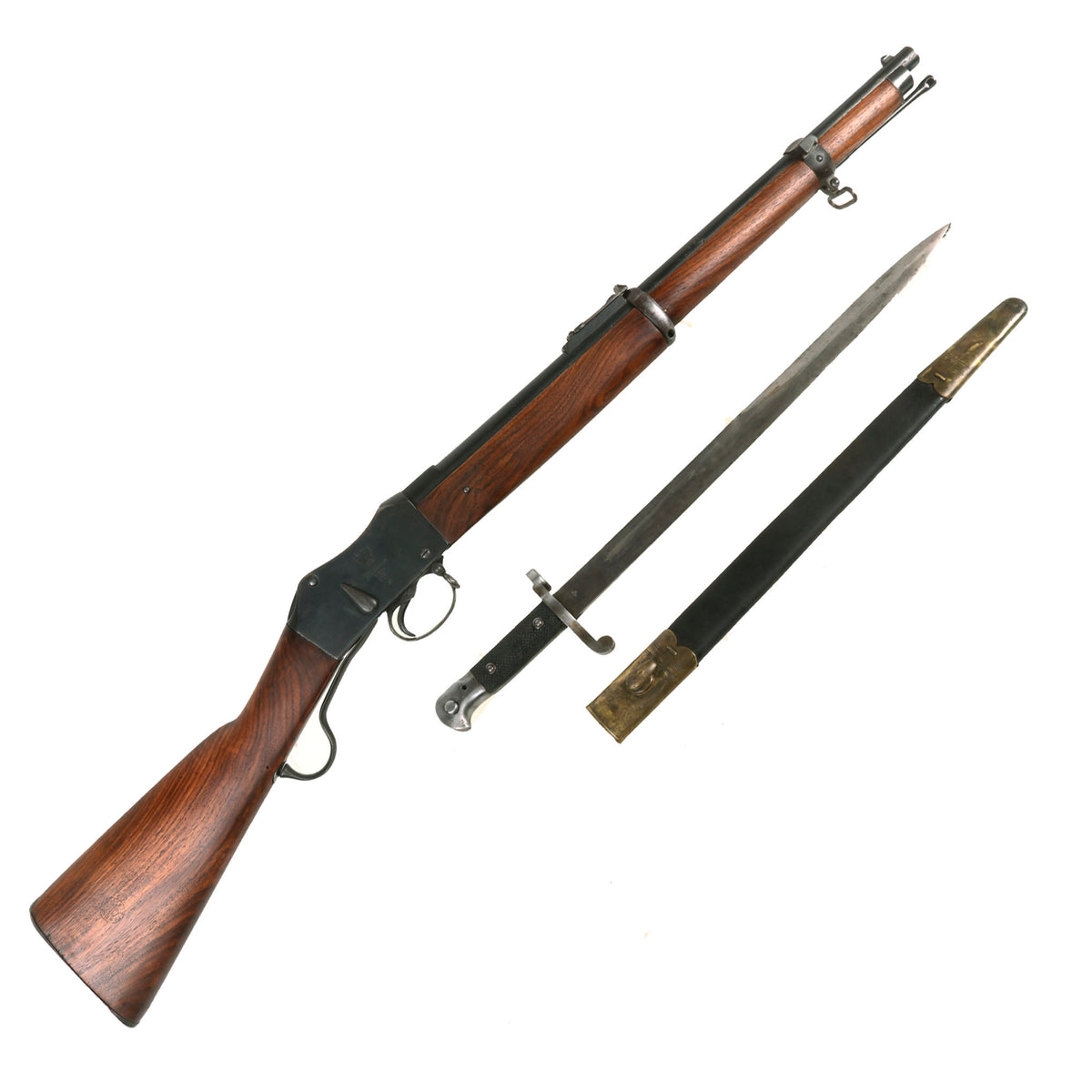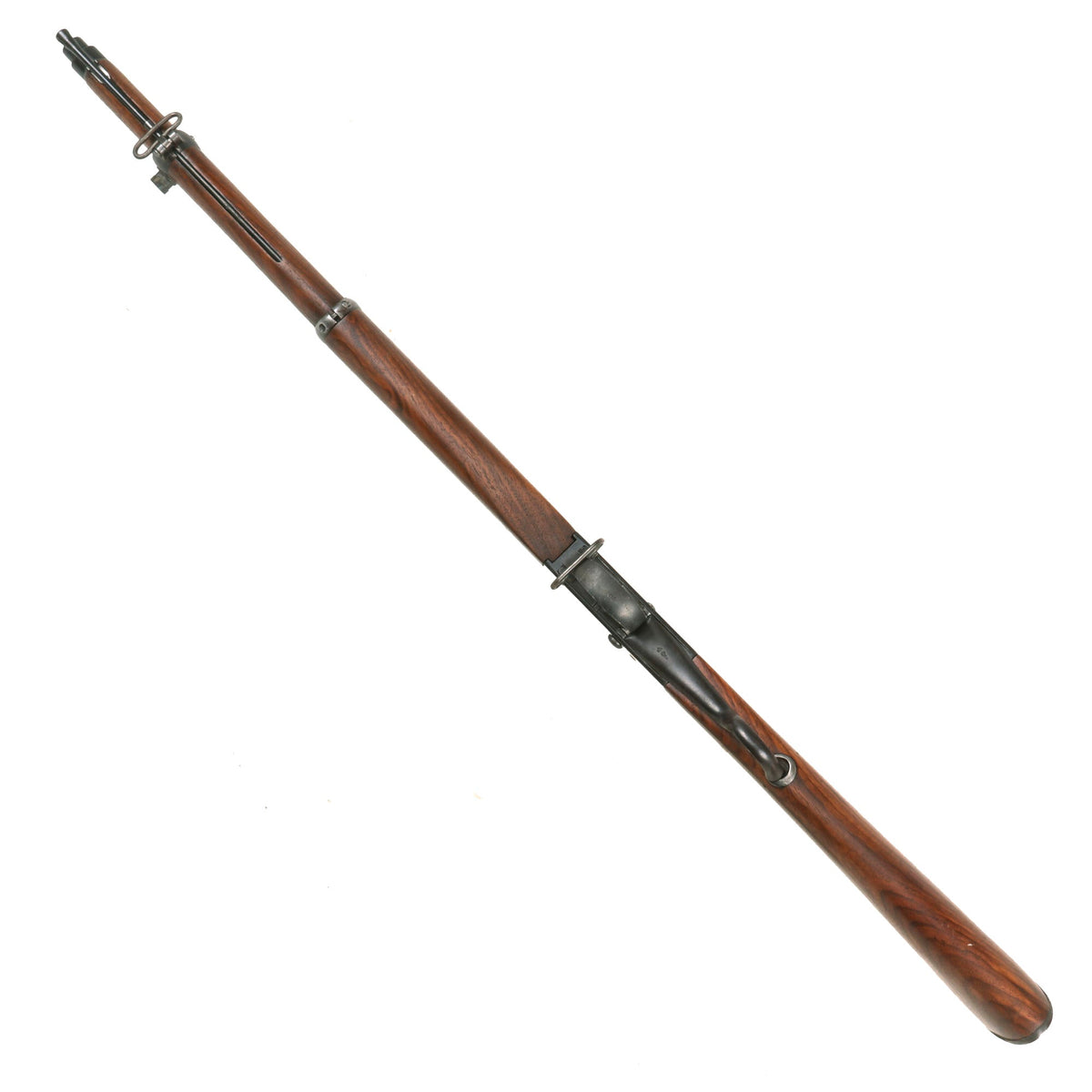Original British P-1871 Martini-Henry MkII Short Lever Rifle Converted to Carbine In Nepal with MkIII Sword Bayonet – Dated 1875 Original Items
$ 1.295,00 $ 323,75
Original Item: Only One Available. The Nepalese cache purchase of 2003 is truly the gift that keeps on giving, even after almost 20 years! The Martini-Henry MkII rifle is best known for its use in the Zulu War at the Battle of Rorke’s Drift on 22nd January 1879. This battle was the iconic defense of the mission station by a small force of British and colonial troops; which saw a record award of Victoria Crosses and restored the faith of Victorian Britain in the Army.
The Martini-Henry is probably the most famous military rifle of the Victorian era incorporating the early short lever with 33″ barrel in the new .45 caliber. This was the first manufactured breech loader to be adopted for general issue by the British Army. Internationally known for its role in the movies “Zulu” and “Zulu Dawn” it should be noted that at the Battle of Isandlwana in January 1879 where the British lost its entire command of 1300 men, the Zulu’s suffered in excess of 2000 casualties. Followed by the memorable action at Rorke’s Drift, the Martini Henry Rifle more than any other represents British Colonial rule during the Victorian era.
This example is definitely a bit different than the typical Martini-Henry MkII Rifles from our exclusive discovery of arms in the royal palace of Nepal. It was shortened by 10 1/2 inches in Nepal, bringing it down to the correct carbine length. It was then fitted with a new stock from locally sourced hardwood, which we have restored to look great. It still has the bayonet lug on the front barrel band, and it comes complete with a MkIII Sword bayonet and brass fitted scabbard. The bayonet ring was enlarged to be able to fit over the wider barrel, as it was not turned down, simply shortened.
The carbine still retains the complete markings on the right side of the receiver:
(Crown)
V.R.
ENFIELD
1875
(Viewer Mark)
II
The “II” mark of arm is off center, indicating this was originally a MkI Martini-Henry, which like almost all was upgraded to MkII early in its service life. There are additional proof marks on the barrel, and the correct N · S / N E P marking on the left side of the barrel under the sight, indicating issue to Nepal. The condition is lovely, having been restored by our antique gun smiths. As we usually see, there is some past pitting along the barrel woodline, and in a few other places. We checked the action, and it functions correctly, with a nice dry fire. The bore also shows the Henry rifling clearly, though there is some past oxidation and fouling, as to be expected. Really a lovely converted carbine.
The included bayonet is in great shape, and has the complete markings still visible on the left ricasso:
(Crown)
V.R.
’89
WILKINSON
SWORD
LONDON
Amazingly, the scabbard and bayonet actually did not receive any Nepalese markings when they were in service there.
A very interesting Nepalese converted Martini-Henry Carbine with sword bayonet, ready to add to your collection!
Specifications(Rifle):-
Year of Manufacture: 1875
Caliber: .577/450 Martini-Henry
Ammunition Type: Centerfire Cartridge
Barrel Length: 21 1/2 inches
Overall Length: 37 1/2 Inches
Action type: Lever Action Falling Block
Feed System: Single Shot
Specifications (Bayonet):-
Blade Length: 18 3/8″
Blade Style: Single Edged Spear Point
Overall length: 23 3/4“
Crossguard: 4”
Scabbard Length: 18 3/4″
NOTE: International orders of antique firearms MUST be shipped using UPS WW Services (courier). USPS Priority Mail international will not accept these. International customers should always consult their country’s antique gun laws prior to ordering.
Fast Shipping with Professional Packaging
Thanks to our longstanding association with UPS FedEx DHL, and other major international carriers, we are able to provide a range of shipping options. Our warehouse staff is expertly trained and will wrap your products according to our exact and precise specifications. Prior to shipping, your goods will be thoroughly examined and securely secured. We ship to thousands clients each day across multiple countries. This shows how we're dedicated to be the largest retailer on the internet. Warehouses and distribution centres can be located throughout Europe as well as the USA.
Note: Orders with more than one item will be assigned a processing date depending on the item.
Before shipping before shipping, we'll conduct a thorough inspection of the items you have ordered. Today, the majority of orders will be delivered within 48 hours. The delivery time will be between 3-7 days.
Returns
The stock is dynamic and we cannot completely manage it because multiple stakeholders are involved, including our factory and warehouse. So the actual stock may alter at any time. It's possible that you may not receive your order once the order has been made.
Our policy is valid for a period of 30 days. If you don't receive the product within 30 days, we are not able to issue a refund or an exchange.
You can only return an item if it is unused and in the same state as the day you received it. You must have the item in its original packaging.
Related products
Uncategorized
Uncategorized
Uncategorized
Uncategorized
Uncategorized
Uncategorized
Uncategorized
Band of Brothers ORIGINAL GERMAN WWII Le. F.H. 18 10.5cm ARTILLERY PIECE Original Items
Uncategorized
Uncategorized
Uncategorized
Uncategorized
Uncategorized
Uncategorized
Uncategorized
Uncategorized
Australian WWII Owen MK1 Machine Carbine SMG Custom Fabricated Replica with Sling Original Items
Uncategorized
Uncategorized
Uncategorized
Angolan Rebel 1970s era 60mm Inert Display Mortar from Angolan Civil War Original Items
Uncategorized
Armoured Fighting Vehicles of the World: AFVs of World War One (Hardcover Book) New Made Items












































































